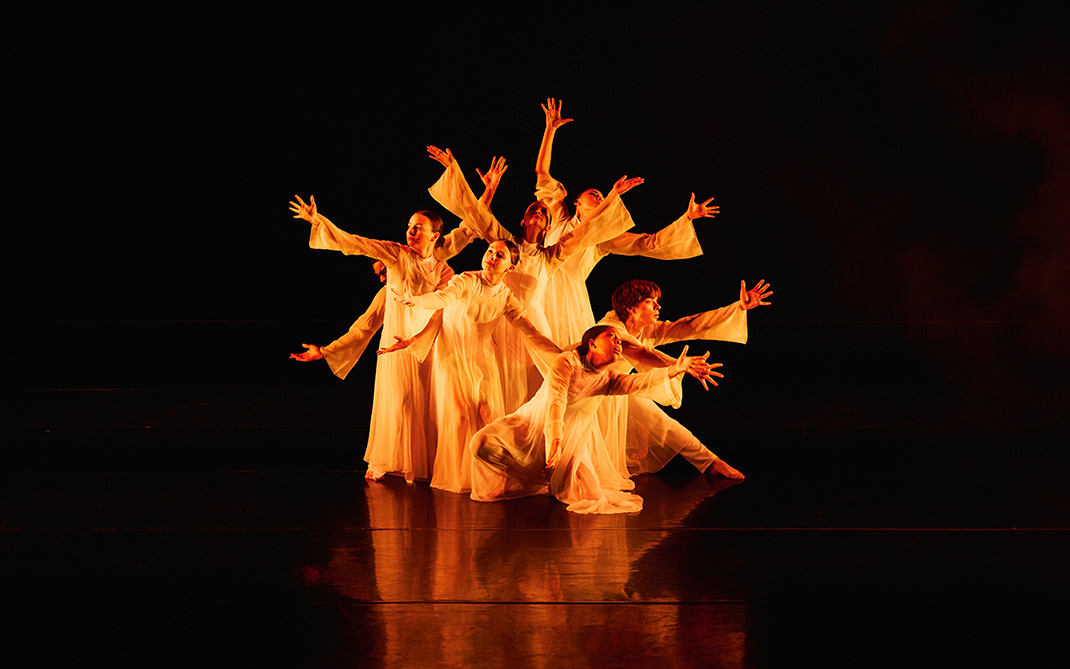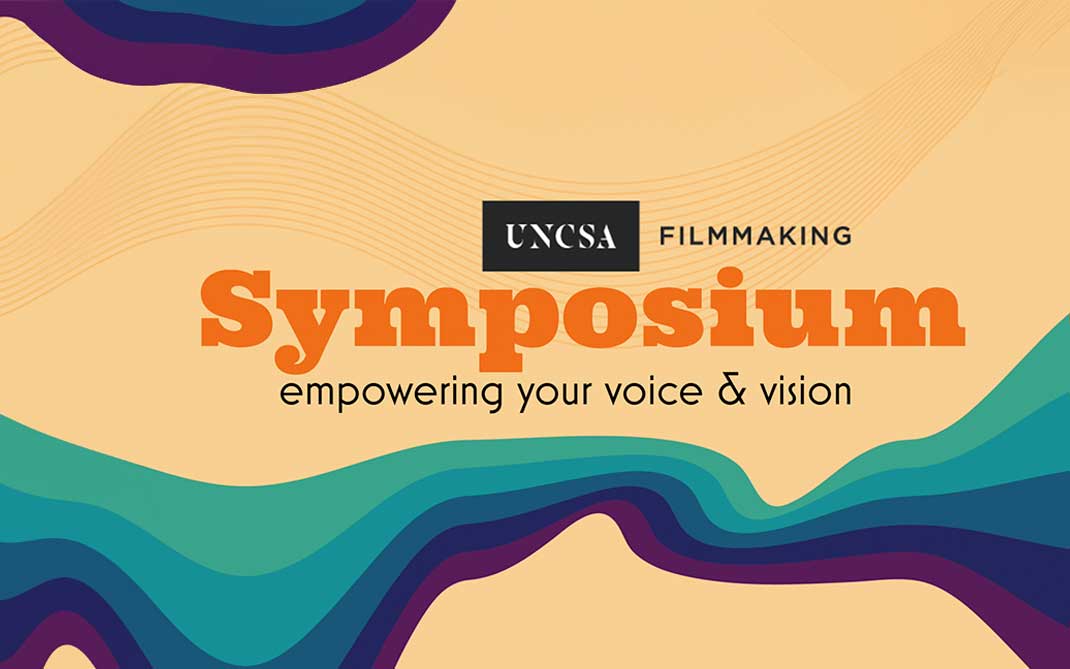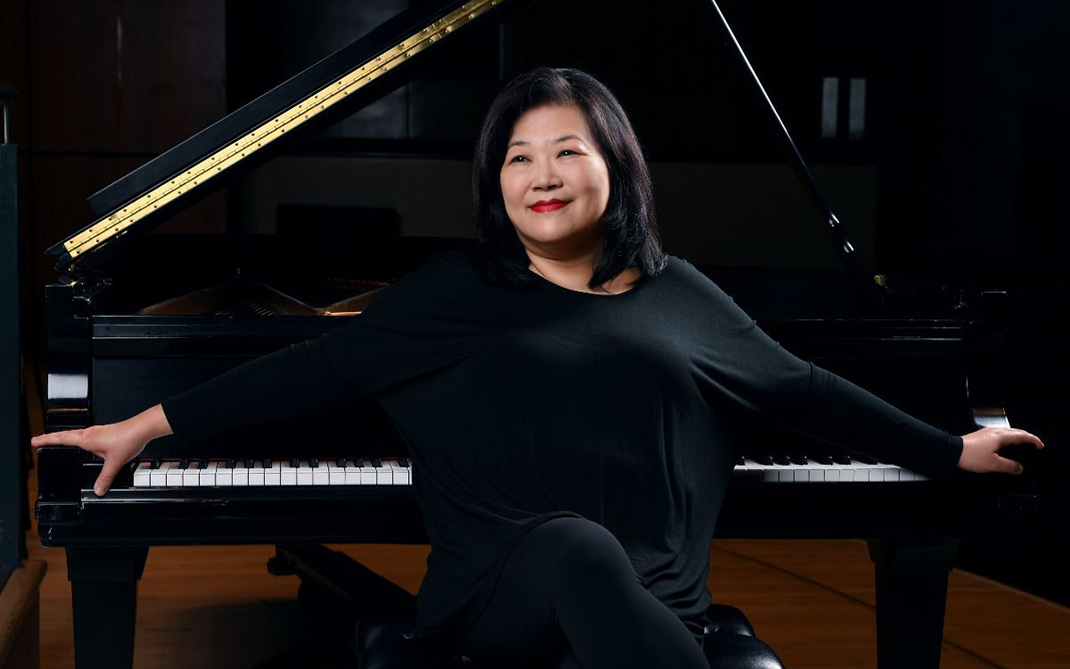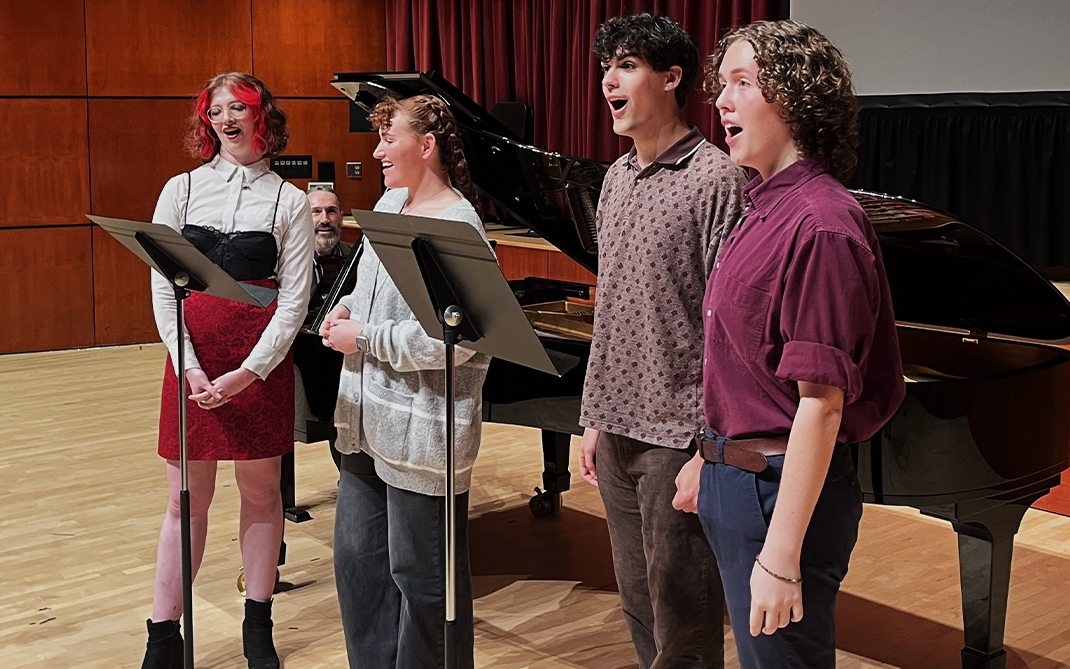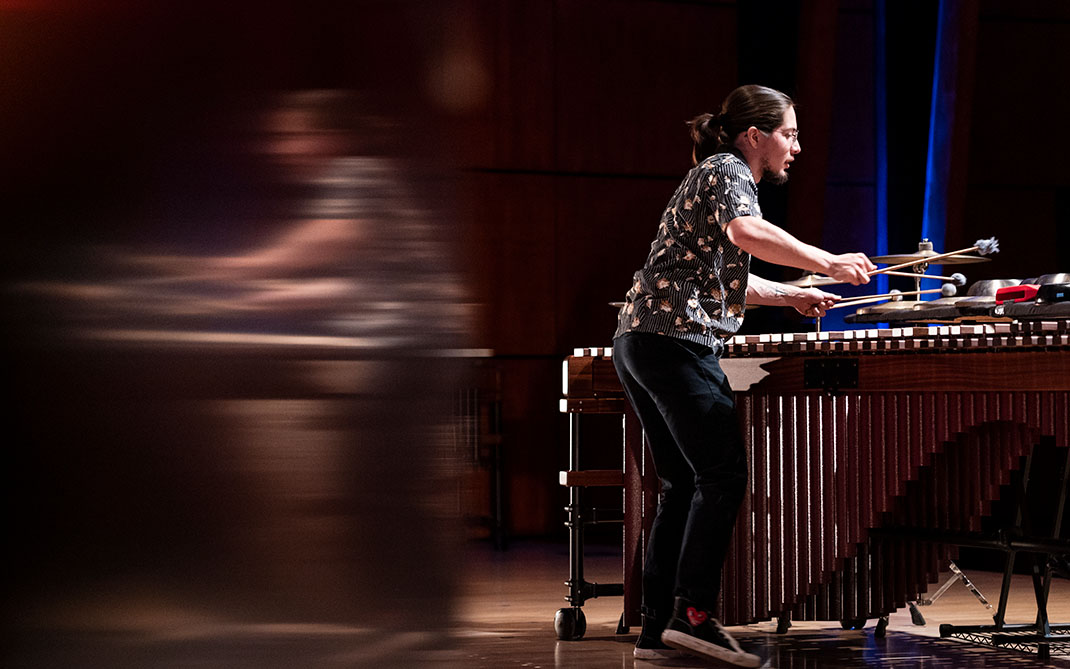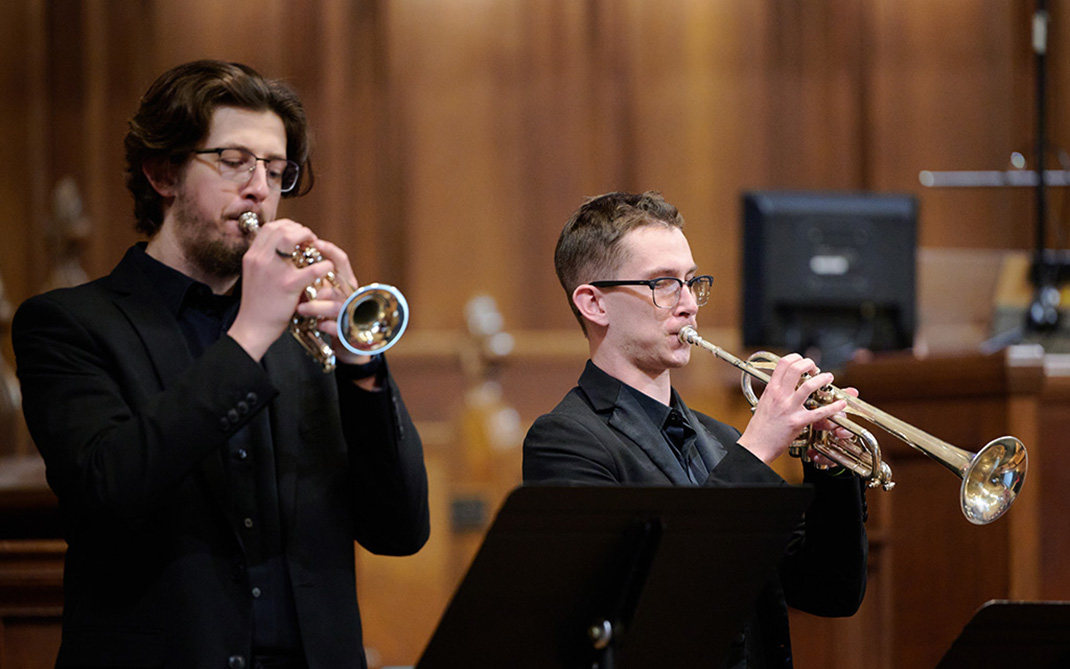Lear deBessonet and Clyde Valentín
The views and opinions expressed by speakers and presenters in connection with Art Restart are their own, and not an endorsement by the Thomas S. Kenan Institute for the Arts and the UNC School of the Arts. This interview has been edited for length and clarity.
It’s a good thing that director Lear deBessonet and producer Clyde Valentín have extensive experience in community-engaged participatory art — nine years ago she founded the acclaimed Public Works program at the Public Theater in New York City; he was the inaugural director of Ignite/Arts, a renowned community-arts incubator in Dallas since 2015 — because the scope of their newest project, One Nation/One Project, would overwhelm most artists and administrators.
One Nation/One Project, a partnership with the National League of Cities, is a truly national multi-year health-and-wellness initiative. Over the next two years, 18 communities scattered throughout the country will create hyper-local participatory and collaborative art works that in July of 2024 will be shared with a national audience. It’s a hugely ambitious project, a reimagining of the 1930s Federal Theatre Project, that looks to capitalize on a well-documented fact, namely that participating in the arts makes individuals and communities healthier.
Among the first cohort of nine sites that One Nation/One Project recently announced is the Kenan Institute’s very own community of Winston-Salem and surrounding Forsyth County. The Institute is working with several local partners — including the Arts Council of Winston-Salem & Forsyth County, Forsyth County Department of Public Health, United Health Centers and the City of Winston-Salem Department of Community Development — to support the program.
The other eight communities chosen are Gainesville, FL; Chicago, IL; Utica, MS; Providence, RI; Rhinelander, WI; Harlan County, KY; Edinburg, TX; and Phillips County, AR, focusing on the cities of Elaine and Helena.
In this interview with Pier Carlo Talenti, Lear and Clyde describe how they conceived and designed their ambitious project and share their hopes for the national healing the 18 local creations might engender.
Choose a question below to begin exploring the interview:
- Lear, I believe you were dreaming of a new Federal Theatre Project years before the creation of One Nation/One Project. How did you finally make it happen?
- Clyde, you have a long history of producing work in communities. What are the special challenges of this one? How did you and Lear work together in developing, for instance, the criteria to be one of the selected 18 communities?
- How did you come up with the prompt question for the project?
- Now, you’ll be working within these nine initial communities that are urban and rural. Since 1936, a much greater percentage of the nation’s populace lives in urban areas, which may be one of the reasons why there is so much more of a greater rural/urban divide than there was 86 years ago. How are you hoping One Nation/One Project might bridge that divide?
- Have there been any unexpected or surprising commonalities across the nine sites that you could not have foreseen?
- Let’s say there’s somebody listening to this episode whose community, for whatever reason, wasn’t selected for the project, or maybe they didn’t even know about this opportunity. How would you suggest to this artist that they might on their own create the kind of healing One Nation/One Project envisions?
Pier Carlo Talenti: Lear, I believe you were dreaming of a new Federal Theatre Project years before the creation of One Nation/One Project. How did you finally make it happen?
Lear deBessonet: The Federal Theatre Project has been on my radar for a long time as this bright star of inspiration. I feel like just naming a couple of the things that remain so deeply inspirational for me about the Federal Theatre Project. I think it’s a unique moment in American history when from 1935 to 1939 this country and the government made a significant investment in arts at the community level, not just arts happening in a couple of urban centers but really the idea that people all over this country deserve to have the arts as part of their daily life, part of the fabric of their lived experience.
One of the unique things about it is that really it was using a moment of societal crisis, which of course feels familiar and resonant right now. They were able to take the Depression and all of the many overlapping crises of their time and energetically move toward how the arts could meet that moment. In a sense, the biggest flaw or vulnerability is that really the whole thing was from one funding source, the federal government. It was a faucet that got turned on, and then one day in Congress in 1939 suddenly the faucet was turned off and it went away.
I think one of the things that I’ve been interested in conceptually is just thinking about what it would mean for a version of a truly national investment in arts and culture at the community level to be held by multiple sectors so that there wasn’t this feeling of a single faucet that could be turned on or off.
Lear deBessonet
I think one of the things that I’ve been interested in conceptually is just thinking about what it would mean for a version of a truly national investment in arts and culture at the community level to be held by multiple sectors so that there wasn’t this feeling of a single faucet that could be turned on or off. Part of what has happened with One Nation/One Project is it’s really about three sectors coming together. It’s local artists and the municipal sectors — cities themselves, the mayor, the city manager and local leaders — and also public-health workers, specifically community-health centers and the network of federally qualified community-health centers. It feels like it takes a cord that thick to be sustainable and strong over time.
Pier Carlo: So when you’re talking about the health of a community and the arts impacting it, it’s not metaphorical health. It’s literal health.
Lear: Oh, yes! Physical health and mental health and societal health. We think about health in all three of those ways.
I think that for me the aspect of this that is really referencing physical health is not something that as an artist I ever expected to have be a part of my trajectory. I’ve been creating community-engaged theater for close to 20 years now, but for about 15 years of those years I’ve been really specifically in this model that became the Public Works model. I spent about close to nine years at The Public Theater founding the Public Works Program there, and that was based on some work that I had piloted in both San Diego and Philadelphia before that.
My entry point to that work was as an artist. I am not a social worker, I’m not a social scientist, and I’m certainly not trained in any sort of medical field or public health. But with that work, documentation was an important piece of it, watching what happened over time and telling the story of individual community members and the group as a whole as they spent multiple years engaged in participation in the arts. Part of what we found that was so remarkable to me was that there really were these drastic health benefits for arts participation. It was everything from people being able to control their diabetes and much lower risk of both depression and dementia and people recovering more quickly from surgeries. The mental health benefits are just enormous; this has been well documented. For senior citizens, increased mobility.
Paloma Hernandez, one of the health partners for One Nation/One Project, was able to frame something really beautifully for me. She talked about how from a public health standpoint two of the biggest obstacles that she, as a person who runs a network of community-health centers, deals with is if people are able to see the doctor when sick and take their medication regularly, just those two things alone make an enormous difference. And yet those are two areas that it’s really hard to figure out the direct solution for those things. It’s not something as simple as an injection, as a vaccine. It’s someone being able to take their medication every day and see the doctor when sick. There’s a lot of social factors that go into that, that relate to where people are in their lives, what support structures they do or don’t have. Those are areas where the arts play an enormous role.
And this is not just in my work. I now know that this has been studied in many, many art practices. Dr. Jill Sonke at the University of Florida Center for Arts and Medicine has done a lot of deep work in this. When someone is participating in an art project where they know that if they are not able to show up at rehearsal the next day, people will notice, they will be missed, their presence is wanted, that is such an incentive to take your medicine and, yes, to go to the doctor when sick and, if you have a stroke and need to do some really difficult physical recovery, to do that because there’s a sense of purpose and meaning.
As human beings, that deep need for meaning and for communion with others, knowing that we matter to other people, those are some of our deepest needs, they are, I would say, [chuckling] medicine-adjacent, but they certainly are part of health and, we know, part of both individuals and communities achieving their best state of wellbeing.
Pier Carlo: Clyde, you have a long history of producing work in communities. What are the special challenges of this one? How did you and Lear work together in developing, for instance, the criteria to be one of the selected 18 communities?
Clyde Valentín: Lots of collaboration with a number of partners. When Lear reached out to me a little over a year ago, I was just enthralled by the idea and the ambitiousness and the scale of the vision and what was possible.
What Lear’s pointing to about what she experienced through her practices is something that we shared when we worked together back in 2015, 2016, on the introduction of the Public Works program here in Dallas, TX, alongside the Dallas Theater Center team. Doing that work, laying the groundwork, building out the collaborations, and then leading up to the rehearsal and production process was transformative for so many of us. And that work continues to this day at the Dallas Theater Center.
I was just like, 'Wow, we get to create a space for more people to engage in this kind of work across the country? And we get to tell that story and give ourselves permission as artists to operate at a scale that is significant and yet non-commercial but arguably with incredible, meaningful and long-lasting impacts?' I was there for it!
Clyde Valentín
So when she reached out with this, I was just like, “Wow, we get to create a space for more people to engage in this kind of work across the country? And we get to tell that story and give ourselves permission as artists to operate at a scale that is significant and yet non-commercial but arguably with incredible, meaningful and long-lasting impacts?” I was there for it! We jumped in, and we started having conversations through the networks that Lear had been cultivating as well as others that I started to bring to the table.
A key individual that connected some dots for us is Dr. Jeff Levi, who’s a professor at George Washington University. He introduced us to his colleagues at the National League of Cities, specifically the Institute for Youth, Education and Families, kind of a subsector within the NLC. We started talking to them about the idea.
At first, I think they were sort of entertaining us as artists and being thoughtful and kind [he laughs], and then we were like, “So what’s it going to take? What’s it going to cost for us to work together?” We know that resources is often the rubber meeting the road. They gave us a number, and Lear and I started going out and raising the money for it.
We modeled our criteria off of some existing frameworks that they had been running. They’ve been running city cohorts related to policy and equity in relationship to policies across cities, towns and villages, their member organizations. What we’ve been doing is creating a synthesis of that framework alongside some of our practices that we and our team members are bringing to the table, synthesizing a cohort process that we’re actually about to embark upon pretty soon. And it’s exciting!
Pier Carlo: I imagine that since you’re not being federally funded, there’s less of a chance that a tap will be turned off for variety of political reasons, as happened in 1939, right?
Lear: That’s right.
Clyde: That’s key there, Pier Carlo, because I think part of the initial vision was to also realize a municipal and public commitment alongside these other aspects. We don’t necessarily use this language explicitly, but the manifestation of each site will be a public/private iteration of the work on the ground. To Lear’s point earlier, hopefully that will make it more sustainable, especially as we’re producing this evidence-based learning that is going to be critical to propelling policy change on the ground around these intersections.
Pier Carlo: How did you come up with the prompt question for the project?
Lear: The prompt is “No Place Like Home.” There was, I think, a really organic process of many conversations around what it could be. I think before we landed at the prompt, we had thought that perhaps we were looking for a play or a book that would be the jumping-off point. In 1936 when they did this, when 18 cities and towns came together and did the same play on the same night, they did Sinclair Lewis’ “It Can’t Happen Here,” which was a popular book that had come out the year before and was a parable about the threat of fascism rising. We had thought about whether a source like that would make sense. Even the title One Nation/One Project in a way is a purposeful echo of One City One Book, which is another thing that had inspired me, the movement that had invited a city to read a book together and engage around that book.
One of the complexities of that, of course, is that in some cases choosing a book has been very controversial. In New York City, for example, there were many years where a lot of other peer cities were doing One City One Book, and New York could not agree on a book. [She laughs.] That seems like a very New York-y thing in and of itself, to be like, “We do not agree on the book.” I think as we had conversations with partners from so many different geographies and backgrounds, it felt like there was something about the theme of home that was feeling really resonant.
We knew whatever this prompt was, it wanted to be an invitation that really encouraged places to represent themselves, to articulate the things that were true about their home that were like no other place ... There was something about the pleasure of hyper-specific local detail that we wanted these works of art to be able to respond to.
Lear deBessonet
We knew whatever this prompt was, it wanted to be an invitation that really encouraged places to represent themselves, to articulate the things that were true about their home that were like no other place — the particular pancakes at this particular diner and the way the gravel on that one road makes your car go bump. There was something about the pleasure of hyper-specific local detail that we wanted these works of art to be able to respond to.
I think that we also wanted the phrase or source to be something that was widely recognizable enough so that it passed what we thought of as the gas-station test, meaning that you could pull up to get gas anywhere in the country and strike up a conversation with whoever was pumping gas next to you and be like, “Hey, I’m working on this project. Are you interested in being part of it? It’s called ‘No Place Like Home.’” We wanted it to be in some way a popular-enough, widely-shared-enough phrase or reference point that really anywhere in the country you could find somebody to be like, “Yeah, I get that. That makes sense.”
I will say that this reference point of “The Wizard of Oz” as something that phrase is clearly linked to in many people’s minds is exciting to us as well. I think we’re yet to be at the point in the process where we’ll see how many places might in some way riff on “The Wizard of Oz,” but I think we expect that there probably will be some places that will. There were things that felt really juicy about that story, both because of its particular Americanness as an American fairytale but also because the bigger metaphor of Dorothy. Dorothy could be anyone. Dorothy could be any American of any possible demographic. We liked the idea that Dorothy has to build a community around her to take this journey together, to go down the yellow brick road and ultimately to try to face the power, confront the wizard and then ultimately discover that the people had the power all along.
It just felt like that there were so many ways that communities could choose to adapt and tell that story about themselves. There’s something also within that Oz narrative that’s about Dorothy taking a journey to ultimately recognize that the everyday people already in her life are magical, are extraordinary, and it takes this full hyper-color journey to recognize that. I think that also felt at a core level very central to what we’re interested in.
Clyde: Indeed. And I would add that what enthralled me about the notion of home and what I think has resonated with many people we’ve been in conversation with is we’ve spent the good majority of our time over the last couple of years at home, right? And we’re all in our various ways — depending on our comfort levels, depending on what part of the country we’re in — negotiating how we move from home to the public square, the public spaces that we grew to know and love around us.
Pier Carlo: Even how we define safety within our respective communities and homes.
Clyde: Exactly. I think it’s reflective of two critical values that I think are embedded in our respective work and in our work together here, which is really about ways in, as many access points as possible, and the importance of truly telling your own story of what that is, the opportunity for people to express their notions of home in the ways that are true to them and their respective place.
To explore environmental racism and justice in the context of home. Or reentry in the context of incarceration. Or housing security. There are all these points that can manifest as each place begins to iterate what they want to tell about themselves alongside that myth. As one of the participating artists in one of the sites said, “This prompt kicked us in the gut in a good way.” That’s been true for me, and I think that’s been true for many people that we’ve introduced the project to.
Pier Carlo: Now, you’ll be working within these nine initial communities that are urban and rural. Since 1936, a much greater percentage of the nation’s populace lives in urban areas, which may be one of the reasons why there is so much more of a greater rural/urban divide than there was 86 years ago. How are you hoping One Nation/One Project might bridge that divide?
Clyde: Ooh, great question! So I’m a native New Yorker, Pier Carlo. I don’t know if you know that, but I was born and raised in Brooklyn, so I grew up in the city.
Pier Carlo: Yeah. [Laughing] Your accent is definitely not Iowa.
Lear: And I’m from Louisiana.
Pier Carlo: Oh, OK, your accent is not Iowa or Louisiana.
Clyde: Well, it’ll slip out depending on —
Lear: [She laughs.] Totally!
Clyde: It’s interesting because when I look East from where I am in Dallas, I’m looking at the Deep South. Louisiana is our state next door; I could be there in three hours. I spent a lot of time in that state. Lear and I were having a conversation about crawfish a couple of days ago, actually.
Lear: Yes, we were! [They both laugh.]
Clyde: And when I look West, I’m in the Southwest, and for me even coming to this geography was a way for me to expand my own cultural literacy about the United States of America. I’ve had the fortunate opportunity to travel and produce in many major cities and colleges and universities in smaller towns. Having spent time in place here, in parts of Mississippi, North Carolina, now across Texas and into the Southwest and New Mexico has been incredible for me to really open my eyes around what I believe to sometimes be the limited discourse on the coasts, the West and the East Coast, about our understanding of what nuance is culturally across our country.
It’s just been a really fascinating entry point into exploring notions of home and how we express them.
Lear: And I think part of the desire for a national project that truly did have both urban and rural and suburban and frontier and reservation — all of those different geographies exist within it — is just to bring forth the awareness of so many of the really painful cultural divides and sticking points.
It feels like we’re essentially as a society in a place of bad faith. We are not in a position of good faith. We’re not in a position of being able to trust and assume that there are shared values and that there’s sort of a shared empathy. I think people on almost every side feel attacked and feel disrespected and not seen in the way they want to be seen. Once things have gotten to a place of bad faith, what does it mean to repair that and to try to find good faith again? It feels like the process of listening is crucial, mutual listening and actually giving people the space to articulate the way they want to be seen.
Pier Carlo: Yeah, witnessing.
Lear: Exactly. Witnessing with empathy, with joy and with the sense of believing that a map of political divides or really any other kind of demographic map that could exist doesn’t tell the truest human story about who we actually are, that each of us as a human being is more complex than our categories. We’re more than what a census report would say about who we are. Certainly we’re more than the portrait that national news might paint of our place or “people like us.” I think that the desire from really all parties, the fact that nobody feels seen, nobody feels taken care of, is a really interesting place for art to step in and play a role because there’s some healing that has to be done. It feels like it’s not healing that’s going to be possible through just policy change; it’s not going to be possible through the existing systems. Certainly we know that the capitalist system is just not set up to do that. Capitalism is not about healing. [She laughs.]
I think the question of what else is there, what are the things that could offer that kind of mending and that kind of just soulful connection, it feels like that’s part of what art can do and must do in this time.
There’s a distinct meta-narrative that I think will begin to emerge as each site begins to tell its own story that I know that Lear and I and some of us on our creative team are intent on also telling, in celebration of the incredible pluralism and diversity that we know make us strong as a country.
Clyde Valentín
Clyde: There’s a distinct meta-narrative that I think will begin to emerge as each site begins to tell its own story that I know that Lear and I and some of us on our creative team are intent on also telling, in celebration of the incredible pluralism and diversity that we know make us strong as a country. I think we have an opportunity to tell that story as well.
Pier Carlo: Have there been any unexpected or surprising commonalities across the nine sites that you could not have foreseen?
Lear: I think part of what has been inspiring is to hear people’s imaginations in these places. In Rhinelander, WI, for example, one of the things that they have acknowledged — it’s a rural community in Northern Wisconsin, and it’s a very particular geography there — and one of the things they have dealt with is youth mental health and in particular youth suicide. Part of the vision that they brought to the table was the idea of a youth arts/skate park, a gathering place that would be very much owned by young people, that they would sort of co-design, that would have a beautiful artistic expression and that could also be a venue for future gatherings. That was such a specific idea that was so particular to that place and thinking about what would work there.
I feel like in Utica, MS, the work that SIPP Culture and Carlton Turner and their friends —
Pier Carlo: Past “Art Restart” guest Carlton Turner!
Lear: Yes, the work that they do in rural Mississippi around food and story is so highly specific to place. It just has been inspiring. And working with our friends in Harlan County, KY at Higher Ground, again, another very particular and unique geography. I think it’s really pointed to how much innovation can happen at the local level and how much local people essentially know what’s going to work there.
When I think about it in the context of my hometown of Baton Rouge, I feel like if someone from the outside said, “We have an idea for a new crawfish franchise that we’re going to start in Baton Rouge. That would be great, right? People in Baton Rouge love crawfish.” But it’s like a person from the outside probably wouldn’t know that like, “Well, actually the best crawfish is really not even had in restaurants. It’s like at people’s houses, it’s in crawfish boils, it’s served in newspaper on tables, and it takes all day. There’s a long cooking process.” All these things that, again, a local person would know.
It feels like in any national endeavor there really has to be a lot of deference to the local authority and a recognition that they’re the authority on their place and really what’s going to work there.
Pier Carlo: How do you think this work you’ll be doing is going to change the way you yourself approach your own art?
Clyde: I’ll say for my myself I’ve really been leaning into intersectionality and cross-sector collaborations with some of what I’ve been doing here in Dallas in particular. This is a doubling-down on that in many, many ways, with the specificity of community-health providers, municipal leadership and artists and arts organizations locally.
I really do believe that there’s more work to be done on this level and that as a country we need to value our culture and thus each other more, not only in the urban cities where we get to eat great food, like in Dallas — there’s wonderful restaurants here — or even in spots in Louisiana and across the country, but really, really being open to, whether it’s close to us or adjacent or far away, just valuing the thing that is different from us and just understanding that it is important because it is a part of the greater us. It feels to me like that’s going to be certainly my trajectory coming out of this, because it is a lifetime’s worth of work to create that kind of transformation for each other in this country.
The NEA is woefully underfunded in the scheme of things. The arts-and-culture sector and philanthropy cannot cover the cost of culture. We could be doing more and doing better for ourselves and each other.
Lear: One piece that is going to be part of this, which is really exciting, is a documentary. That is partly there to make sure that the beautiful things that happen on the ground in these 18 places, that it’s not solely the people who live in those 18 places who get to participate in and benefit from those stories. I would say it’s been pretty recent for me that I’ve started doing any work in film/television. I do consider myself a theater maker at my core, but I think it’s crucial to find ways that film and television can both preserve the very ephemeral work that is theater and also make it possible for that work to be shared across geographies.
I think the pandemic also has brought for all of us new ways of working, in terms of the presence of Zoom in our lives, and there are ways that One Nation/One Project is actually very well served by those technologies that we now know how to use that allow us to have meetings with people who are in other cities. It feels like to some extent, community-engaged artmaking will always be local and in-person work because it’s deeply relational, but there is a kind of magnifying power that exists that I’m really interested in thinking about right now. So, yeah, that is certainly on my mind.
Pier Carlo: Let’s say there’s somebody listening to this episode whose community, for whatever reason, wasn’t selected for the project, or maybe they didn’t even know about this opportunity. How would you suggest to this artist that they might on their own create the kind of healing One Nation/One Project envisions?
One Nation/One Project is not a fixed, finite moment. The invitation and the values of it are something that are so large and encompassing and essentially like a lifelong invitation for all of us.
Lear deBessonet
Lear: One Nation/One Project is not a fixed, finite moment. The invitation and the values of it are something that are so large and encompassing and essentially like a lifelong invitation for all of us. I don’t think there’s any need to feel, “Whoa, if one is not participating in this particular iteration and round … .” I think that the core principle of holding hands with people who have other expertise —if you’re an artmaker, considering the expertise of city leaders and community health workers and believing that there is a collaboration to be had there — is part of the animating spark here, and I think that is something that anyone can do.
In fact, even those three sectors are not meant to be exclusive. There are other parts, other ideas. We’ll see how this all comes to fruition. For example, we know that we’re deeply interested in libraries and in partnerships with libraries. I think in many individual places there will be other community partners, other nonprofits that join the team. I think fundamentally for any artist to be interested in people outside of the arts from other sectors and to really go into conversation, looking for opportunities to collaborate and to bring mutual expertise to the table, it feels like that’s at the core of this. And that is an ongoing invitation for anyone anywhere.
June 20, 2022
